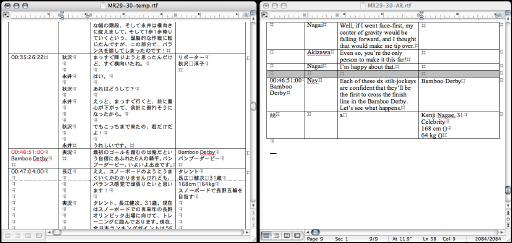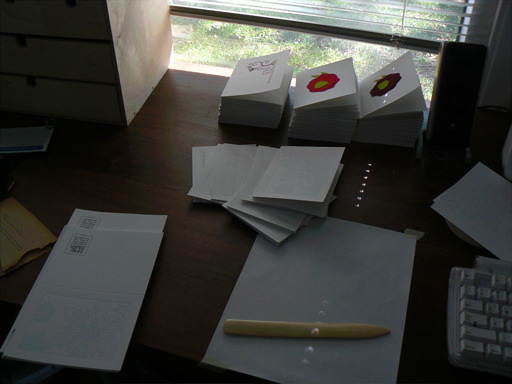Gwen and I recently flew up to Chicago. The excuse for our visit was my mom’s 70th birthday, but of course there’s more to do in Chicago than attend birthday parties, so we made a five-day trip out of it.
After a way-too-early departure from Austin, we arrived in Chicago with all of Thursday ahead of us. Took the blue line down to the Damen stop, where my sister met us with her car and took us back to her new condo in Old Town. It’s a great place. It’s an older building that has been through (really, is still going through) a gut rehab. It’s also less than two blocks away from Nookie’s, to which we promptly proceeded as soon as we got our stuff situated. Coffee, omelettes, and toast while sitting out on Wells Street enjoying the feeling of being on vacation on a nice day. That’s a good feeling.
Afterwards, we did what I like to do best in Chicago, which is just wander around. We wandered up and down Armitage, Webster, taking in the chi-chi boutiques in that area. Picked up a housewarming present for my sister. Gwen had just embarked on a commercial letterpress project, and many of the shops where we stopped had letterpressed cards of some variety or another. We wound up doing quit a bit of research. That night, a fellow firedancer who I know through the Internet, Kathleen, hosted a small spin jam at her apartment. It wound up being more of a social hour than spin jam, but that was fine, because it was an interesting crowd. And it was nice just making that connection in person. Whenever I go somewhere new, I look forward to meeting the fire folk there–I feel we’re members of the same tribe.
Friday, we had the pleasure of getting together with an Austin friend, Heather, who just happened to be in Chicago on business at the same time. We did more wandering around, walking until our feet were sore. They tried on shoes; I watched. We stopped by Ethel’s Chocolate and indulged. Stopped in Paper Source, where Gwen and Heather both bought stuff. That night, Gwen, Heather, my sister, and myself had dinner at Pasta Palazzo. My sister had never been there, surprising because it’s a really good restaurant, and it’s not even a ten-minute walk from her place. The kitchen is right out in the open at the lunch counter, and it is fun to sit and watch your order being prepared. A bit unnerving, though, when you see the extraordinary quantities of half-and-half and/or butter that go into making your meal so tasty.
Saturday was the day of my mom’s party, but that was at night. In the morning, Gwen and I went wandering southward, initially hoping to find a bakery (and walking right past one in my sister’s neighborhood), but eventually getting to a farmer’s market on Division, where we did procure some baked goods and wandered back north, eventually getting to another farmer’s market right next to the Farm in the Zoo, where we saw cabbages the size of pumpkins. We made our way over to Nookie’s for some sustenance after all that walking, where my aunt Sandy and her husband Joe intercepted us. We hung out for a while and went back to my sister’s to get ready.
The party was in a large private room at a huge rambling restaurant near where my parents live. The party was intended as a surprise. My mom had an idea that something was up (she knew I’d be coming to Chicago “around her birthday”), but I don’t think she had any idea how many people would be there, several others who flew in from as far away as I did.
Gwen and I spent that night at my parents’ place, and got to see the very nice new porch they’d put on, the refreshed kitchen, etc. Not much headway reducing clutter, though. My mom’s big ongoing project has been turning large chunks of their property into prairies with native plants. She’s got three pretty big fields going, all with numerous plants. I don’t know from beans when it comes to this sort of thing, but it looked good and was obviously a lot of work.
The next morning, my other sister came down from her hideout in the 815 area code and we all went out for a too-big meal in Barrington (too-big meals were really a theme of this trip). After that, Gwen and I caught the Northwestern line down to Clybourn and walked the rest of the way back to my sister’s place, past the Finkl steelworks. Later in the day, Gwen and I reconnected with my parents at my cousin Joel’s condo; from there, we went on to the Garfield Park Conservatory, where there was a sculpture show (pictures).
That night, Gwen, my sister, and I went out to Bacino’s for stuffed pizza, something I try to get on every trip to Chicago. The sauce seemed a little underdone this time. A stuffed pizza should really have a solidified, somewhat paste-like sauce. This was still kind of runny. Bacino’s used to be the best place to go for stuffed pizza, but I’m not able to monitor developments in the Chicago pizza world as closely as I might like. Perhaps the mandate of heaven has passed to another joint. Maybe I’ll try Leona’s next time—they were always reliable.
And then came Monday, our last day. Our flight was late in the day, so we went to Bucktown and, well, walked around some more. We stopped at the Fluevog shop, where Gwen came very, very close to buying a pair of shoes. We stopped in a vintage shop, where one of the clerks instantly marked us as tourists—perhaps because we were out as a couple during normal working hours. Eventually, of course, the trip had to end. My mom, who happened to be in the city, had offered to drive us to the airport, but we convinced her to just drop us off at the El station, which was probably a faster way to get to the airport. Our flight home was uneventful and relatively unburdened by new purchases.
A big part of the reason I love walking around Chicago is because of the architecture. Typical residential architecture is built to a vastly higher standard there than here in Austin, and much of it is interesting to look at as well. It’s one of the differences in regional culture. When I first came to Austin and looked at some of the apartments where regular people lived, I thought “These are temporary buildings, right? Or student housing?” I guess I’ve reconciled myself to the flimsy construction here, because this visit was a forceful reminder of how much better construction is in Chicago. And there’s a hell of a lot of new, really posh construction going on as well. The Chicago I grew up with was a city in decline—the population was shrinking, the streets and parks were not well maintained, and there was not much new construction. All those trends have reversed, and indeed there are parts of the city that are unrecognizable. My sister’s neighborhood is seeing a rash of very plush townhouses going up—enough so that the neighborhood association is upset about them hurting the character of the neighborhood.
There were other little differences in regional culture I noticed. In Austin, you can pay for damn near anything with plastic. Many businesses in Chicago won’t accept plastic. In Austin, everyone has sunglasses on a sunny day. Chicago? Not so much.
Then there’s the big cultural difference: the walking. In Chicago, everyone walks. Everyone has to walk to get somewhere. Even if you drove, you may have parked far enough away that you’ll still wind up walking a distance that many Austinites would consider unwalkable. And because everybody in this big, diverse, dense city is out walking, you rub elbows the complete spectrum of humanity. Just being on the street in Chicago feels very different because of this, and this may help explain why I like walking around Chicago myself. In Austin, the only people you see walking are people who have no other option, or people out for a walk.



